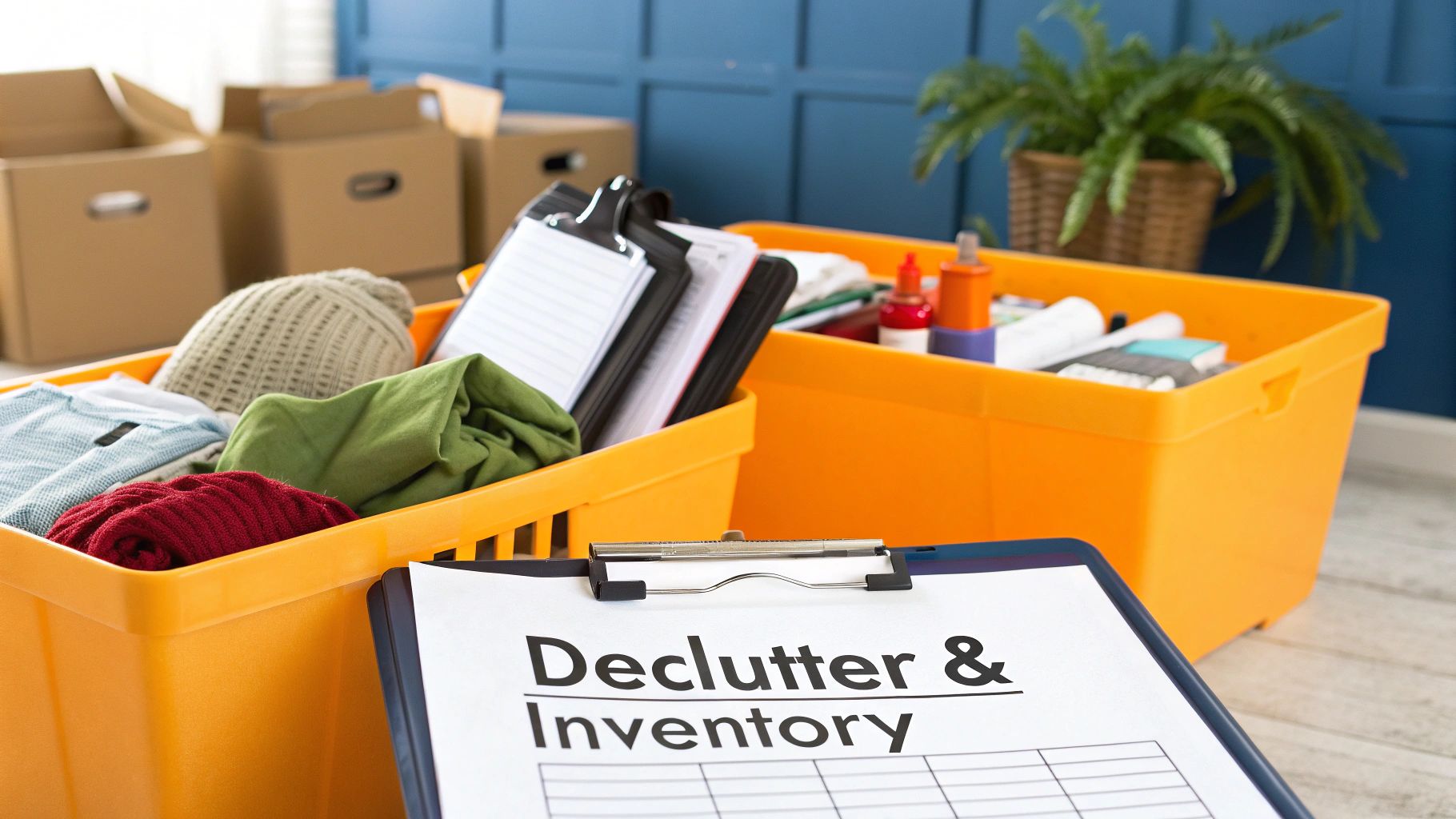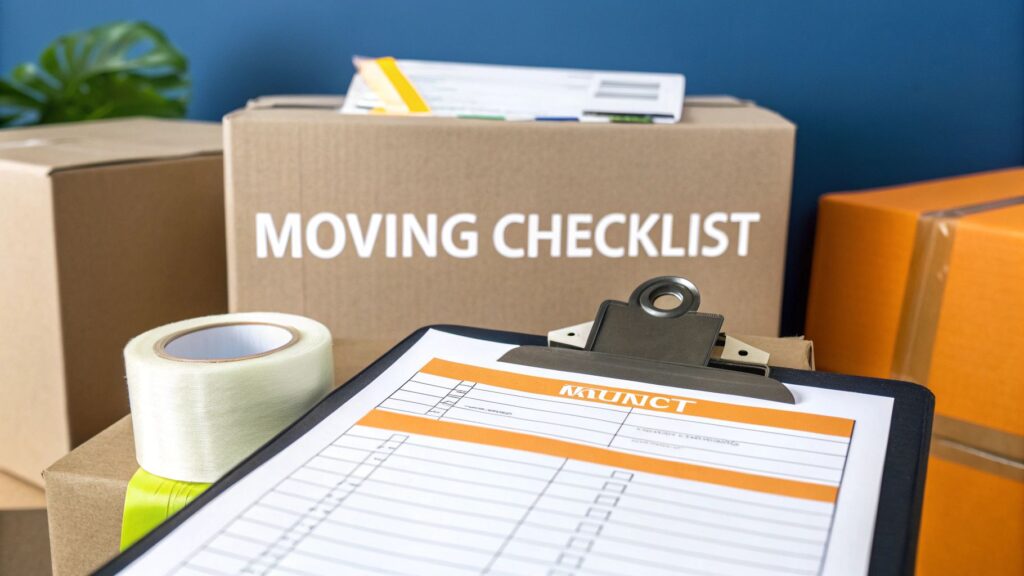Relocating is consistently ranked among the most stressful life events, but meticulous planning can transform the experience from chaotic to controlled. The key to a smooth transition lies not in hope, but in a well-executed strategy. This guide is designed to be your definitive moving house checklist, a phase-by-phase roadmap that breaks down the entire process into manageable, actionable steps. From the crucial eight-week countdown to the final box being unpacked, we will guide you through every critical task, ensuring nothing is left to chance.
Our comprehensive listicle covers everything you need to organise a successful move. We'll detail how to create a moving timeline, research and book reliable movers, systematically declutter your belongings, and manage the essential but often-overlooked administrative tasks like changing your address and transferring utilities. Each stage is presented with practical advice and specific implementation details to help you stay on track and avoid common pitfalls. For those who like to compare different organisational methods, you might find another comprehensive moving house checklist useful for a different perspective on structuring your plan.
Whether you're a first-time mover or have relocated multiple times, this checklist provides the structure needed to minimise stress and maximise efficiency. By following these organised phases, you can ensure that your moving day is less about last-minute panic and more about the excitement of starting a new chapter in your new home. Let’s begin the journey to a seamless and well-organised move.
1. Create a Moving Timeline (8-12 Weeks Before)
A successful, low-stress move begins not with packing boxes, but with careful planning. Establishing a comprehensive timeline is the foundational first step in any robust moving house checklist, acting as your central roadmap. This involves creating a detailed, week-by-week schedule that breaks down every task, from initial research to settling into your new home, typically starting 8 to 12 weeks before your moving date.
This structured approach transforms an overwhelming project into a series of manageable, bite-sized tasks. Professional moving companies like United Van Lines and corporate relocation specialists rely on these detailed timelines to ensure every logistical detail is covered, preventing last-minute chaos and costly oversights. By working backwards from your move-in date, you can allocate sufficient time for each critical stage.
Implementing Your Moving Timeline
To create your own schedule, start with the final date and map out key milestones in reverse. A successful move hinges on solid planning; exploring effective time management strategies can help you build a comprehensive and realistic moving timeline.
Here are some actionable tips to get started:
- Go Digital: Use a digital calendar like Google Calendar or a project management tool like Trello. You can set reminders, assign tasks to family members, and access the plan from any device.
- Colour-Code Categories: Assign different colours to specific task types, such as orange for packing, blue for administrative tasks (e.g., updating addresses), and green for finances (e.g., paying deposits).
- Build in Buffers: Always add extra time around major deadlines. If you plan to have a room packed by Friday, give yourself a buffer until Sunday to account for unexpected delays.
This infographic outlines the critical first steps in your moving timeline, visualising the essential tasks for the initial planning phase.
The visual progression highlights how foundational tasks build upon each other, starting with high-level planning and moving towards concrete actions like booking services.
2. Research and Book Moving Company (6-8 Weeks Before)
Selecting the right moving company is one of the most critical decisions in your entire relocation process. This step involves more than just finding a service to transport your belongings; it's about entrusting your entire household to a professional, reliable partner. Starting this process 6 to 8 weeks before your moving day ensures you have adequate time to research, compare, and secure a reputable firm, avoiding the stress of last-minute bookings and potential scams.
A methodical approach to choosing movers is a cornerstone of any effective moving house checklist. Esteemed national movers like Atlas Van Lines and consumer advocacy groups all emphasise the importance of due diligence. This phase is about vetting potential companies, understanding service offerings, and securing a fair, transparent price, which guarantees your possessions are handled with care and professionalism from your old home to your new one.
Implementing Your Moving Company Research
To find the best fit, you must compare multiple options based on cost, reputation, and services. A thorough vetting process will protect you from hidden fees and unreliable service, forming a crucial part of your moving checklist.
Here are some actionable tips to get started:
- Obtain Multiple Quotes: Always get at least three in-person or video-survey written estimates. This gives you a clear comparison of costs and services and helps you identify any unusually high or low quotes, which can be a red flag.
- Verify Credentials: Check that the company is properly licensed and insured. For moves in the UK, look for members of the British Association of Removers (BAR), which requires members to adhere to a strict code of practice.
- Scrutinise Reviews: Don't just rely on testimonials from the company's website. Read reviews on independent platforms like Google, Trustpilot, or Which? Trusted Traders to get an unbiased view of customer experiences.
- Clarify All Costs: Ask direct questions about potential extra charges. Enquire about fees for navigating stairs, long-carry distances from the van to your door, packing materials, or temporary storage to avoid unexpected bills. Booking early, especially for moves during peak season (May to September), is essential as reputable companies get booked up quickly.
3. Declutter and Inventory Belongings (4-6 Weeks Before)
One of the most impactful steps in any moving house checklist is systematically decluttering your home. This process involves sorting through all possessions to decide what to keep, donate, sell, or discard, significantly reducing the volume and weight of your move. A thorough clear-out not only lowers removal costs but also simplifies the packing and unpacking process, allowing you to start fresh in your new space.

This organisational stage has been popularised by figures like Marie Kondo, whose KonMari Method encourages keeping only items that "spark joy," and minimalist advocates like Joshua Fields Millburn. The principle is simple: the less you have to move, the easier, faster, and cheaper the entire relocation will be. Creating a detailed inventory alongside this process is also crucial for insurance purposes and for keeping track of your belongings during transit.
Implementing Your Decluttering and Inventory Plan
Begin this process room by room to avoid feeling overwhelmed. If you find yourself with items you wish to keep but don't have space for immediately, exploring solutions for moving home storage can be an effective way to manage your belongings without cluttering your new property.
Here are some actionable tips to get started:
- Categorise Your Items: Use a simple four-box method for each room: Keep, Donate, Sell, and Bin. This forces you to make a decision about every single item.
- Start with Low-Hanging Fruit: Begin with areas that have less sentimental attachment, such as the laundry room, kitchen cupboards, or linen closet, to build momentum.
- Digitise Sentimental Items: For items you can't keep but want to remember, take high-quality photographs. This allows you to preserve the memory without taking up physical space.
- Create a Detailed Inventory: Use a spreadsheet or an app to list everything you are moving. Include item descriptions, their condition, and photos, which will be invaluable for any potential insurance claims.
4. Start Address Change Process (4-6 Weeks Before)
Updating your address across all relevant services and organisations is a crucial administrative task in any moving house checklist. This comprehensive process ensures the seamless continuity of your mail, subscriptions, and essential services, preventing critical communications from getting lost. It involves systematically notifying government agencies, financial institutions, utility providers, and personal contacts of your new residence, typically starting 4 to 6 weeks before you move.
This proactive approach safeguards you from missed bills, service interruptions, and even potential identity fraud. Government agencies like the DVLA and HMRC, along with financial institutions such as Barclays or HSBC, rely on accurate address information for official correspondence. Failing to update these records in a timely manner can lead to significant administrative complications and delays in receiving important documents.
Implementing Your Address Change Plan
To execute this process efficiently, begin by creating a master list of every organisation and individual who needs to be informed. A thorough plan is vital for a smooth transition; using a digital spreadsheet can help you track who has been notified and when.
Here are some actionable tips to get started:
- Prioritise Official Bodies: Start with the most critical entities. This includes updating your driving licence with the DVLA, informing HMRC for tax purposes, and changing your address on the electoral roll to maintain your right to vote.
- Utilise Royal Mail's Redirection Service: This is a vital safety net. Royal Mail can redirect your post from your old address to your new one for a set period (3, 6, or 12 months), catching any mail from senders you may have overlooked.
- Notify Financial and Insurance Providers: Contact your banks, credit card companies, pension providers, and insurance companies (home, car, life, and pet). An incorrect address can invalidate insurance policies, so this step is non-negotiable.
- Update Subscriptions and Services: Don't forget about magazine subscriptions, online shopping accounts like Amazon, streaming services, and any club memberships. This prevents service disruptions and ensures deliveries arrive at the correct location.
5. Gather and Organise Important Documents (3-4 Weeks Before)
Amidst the physical chaos of packing, securing your vital documents is a critical task that often gets overlooked. This crucial step in your moving house checklist involves gathering, organising, and safely storing irreplaceable paperwork like birth certificates, passports, driving licences, insurance policies, and financial records. Proper document management ensures you have immediate access to necessary information and prevents the catastrophic loss of items that are difficult or impossible to replace.
This methodical approach is standard practice in high-stakes relocations. For instance, military families are renowned for creating comprehensive 'PCS binders' (Permanent Change of Station) containing every essential document for a smooth transition. Similarly, corporate relocation services often include professional document organisation to ensure employees can manage legal and financial matters without disruption. By treating your personal documents with the same level of importance, you safeguard your identity, finances, and legal standing during the move.
Implementing Your Document Management Plan
To begin, designate a single, secure location for all important paperwork. A successful move hinges on meticulous organisation; dedicating time to this ensures peace of mind long after you've unpacked.
Here are some actionable tips to get started:
- Create Digital Backups: Scan or take high-quality photos of every important document. Store these copies in a secure, encrypted cloud service like Dropbox or Google Drive, ensuring you have access even if the originals are misplaced.
- Use a Secure Physical Container: Invest in a fireproof and waterproof lockbox or safe to store original documents like passports, wills, and property deeds. This container should travel with you personally, not in the moving van.
- Organise by Category: Use clearly labelled folders or a concertina file to sort documents into categories such as 'Identification', 'Financial', 'Property', 'Medical', and 'Vehicle'. This makes finding specific papers effortless.
- Carry Essentials Personally: On moving day, keep a dedicated bag or folder containing the most critical documents you might need immediately, such as your driving licence, new property lease or deed, and passports.
6. Handle School and Medical Records Transfer (3-4 Weeks Before)
A smooth transition for your family goes beyond just moving belongings; it involves the careful management of crucial personal records. Transferring school and medical files is a vital part of any comprehensive moving house checklist, ensuring continuity of education and healthcare without interruption. This process requires you to formally request, receive, and forward sensitive documents like academic transcripts, immunisation histories, and medical files to new institutions.
This proactive step is essential for preventing stressful delays in school enrolment or gaps in medical treatment. Organisations dedicated to supporting transitioning families, such as the Military Child Education Coalition, and large healthcare systems like Kaiser Permanente, have streamlined procedures for this very purpose, highlighting its importance in logistical planning. A well-managed transfer ensures your family’s educational and health needs are met from day one in your new community.
Implementing Your Records Transfer
Begin this process at least 3 to 4 weeks before your move, as administrative processing times can vary significantly between institutions. Starting early provides a buffer to resolve any potential issues, such as missing documents or additional vaccination requirements in a new school district.
Here are some actionable tips to manage this process effectively:
- Request Early: Contact current schools and healthcare providers as soon as you have your moving date. Formally request all necessary records, including academic transcripts, attendance records, special education plans, and complete medical histories.
- Secure Physical and Digital Copies: Whenever possible, obtain both physical and digital copies of all records. Carry the physical copies with you during the move to ensure you have immediate access upon arrival if needed for urgent registrations.
- Research New Requirements: Investigate the specific enrolment and health requirements for your new school district and local medical practices. This includes checking for any mandatory vaccinations or required health screenings that may differ from your previous location.
- Establish New Contacts: Identify and make contact with new doctors, dentists, and schools before you move. Forward the records directly to them and schedule initial appointments or registration meetings to streamline the transition.
7. Plan Packing Strategy and Gather Supplies (2-3 Weeks Before)
An efficient move is built on a smart packing strategy, which begins in earnest around two to three weeks before your moving day. This crucial step in your moving house checklist involves more than just putting items into boxes; it’s about creating a systematic plan to protect your belongings, streamline the packing process, and ensure a logical, stress-free unpacking experience. A well-thought-out approach saves time, minimises the risk of damage, and prevents the chaos of searching for essential items upon arrival.
This phase is where the logistical plan from your timeline becomes a physical reality. Companies that specialise in moving supplies, like U-Haul, offer detailed packing guides and supply calculators, while professional organisers provide structured packing services. This organised approach transforms a daunting task into a series of manageable steps, ensuring everything is accounted for and properly secured for transit.

Implementing Your Packing Strategy
Start by taking inventory of your home, room by room, to estimate the quantity and type of packing supplies you'll need. Decide what you can pack yourself and what might require professional handling. For items you won't need immediately but want to keep safe, using secure short-term storage options can be an excellent way to declutter the process.
Here are some actionable tips to get started:
- Create a "First Day" Box: Pack a clearly labelled box with essentials for your first 24 hours in the new home. Include toiletries, a change of clothes, basic kitchenware (kettle, mugs, tea), phone chargers, and any necessary tools.
- Label Systematically: Label every box on at least two sides with its contents and the destination room (e.g., "KITCHEN – Mugs & Glasses"). This saves immense time and effort during unpacking.
- Use Soft Items as Padding: Save money on packing materials by using clean clothing, towels, and linens to wrap fragile items or fill empty spaces in boxes.
- Mind the Weight: Pack heavy items like books and documents in smaller boxes to make them easier to lift and prevent injuries. Lighter, bulkier items like duvets can go in larger boxes.
- Document Valuables: Before packing, take clear photos of valuable or fragile items. This provides a record for insurance purposes in the unlikely event of damage.
8. Arrange Time Off Work and Coordinate Moving Day (1-2 Weeks Before)
Successfully navigating moving day itself requires more than just packed boxes; it demands meticulous coordination of your personal schedule and logistical arrangements. This crucial step in your moving house checklist involves securing adequate time off from work and synchronising every detail with your moving company, building management, and any helpers. Properly organising this phase ensures you have the necessary time and resources to manage the move without creating professional disruptions or last-minute logistical failures.
This coordination is a standard practice recommended by human resources professionals and corporate relocation specialists to promote work-life balance and reduce employee stress. By aligning your work leave with the movers' arrival, elevator bookings, and childcare arrangements, you transform a potentially chaotic day into a structured, manageable event. This foresight prevents the costly and stressful scenario of movers arriving while you are still in a meeting or discovering the service lift is unavailable.
Implementing Your Moving Day Coordination
To ensure a seamless transition, your focus should be on clear communication and advance planning. Treat moving day like a critical project deadline, with all stakeholders informed and all resources allocated.
Here are some actionable tips to get started:
- Request Leave Early: Submit your time off request as soon as you have a confirmed moving date, especially during peak seasons like summer. Aim for at least one full day dedicated to the move itself, plus an extra day for unpacking if possible.
- Confirm Timings: A week before the move, reconfirm the exact arrival window with your moving company. Share this timing with your building management to book any necessary service lifts or reserve parking spaces.
- Arrange Support: Organise childcare or a pet-sitter for the day to ensure children and pets are safe and out of the way. If friends or family are helping, confirm their roles and timings in advance.
- Prepare Both Properties: Ensure you have the keys and access to your new home before the movers arrive. Likewise, make sure someone can remain at your old property until the very last item is loaded onto the lorry.
9. Prepare Utilities and Services Transfer (1-2 Weeks Before)
Ensuring a seamless transition of essential services is a critical step in any moving house checklist, preventing the unwelcome surprise of a dark, cold, or disconnected new home. This process involves coordinating the disconnection of services at your old address with the activation of services at your new one. Proper scheduling for utilities like electricity, gas, water, and internet is vital for immediate comfort and functionality upon arrival.
This logistical task is fundamental to making a new house feel like a home from day one. Utility companies and service providers, such as BT or Virgin Media, have streamlined processes specifically for home movers, recognising the importance of continuity. Neglecting this step can lead to days without essentials, creating unnecessary stress and complicating the initial settling-in period. Scheduling these transfers 1-2 weeks in advance provides a sufficient buffer to handle any administrative hurdles.
Implementing Your Utilities Transfer
To manage this effectively, begin by compiling a list of all your current service providers and their contact details. Many, like major energy suppliers, offer online portals to schedule a move, simplifying the process considerably.
Here are some actionable tips to get started:
- Schedule Early Activation: Arrange for utilities at your new home to be activated at least one day before you move in. This allows you to test everything and ensures the property is ready for your arrival.
- Compile a Master List: Keep a document with all your account numbers, provider names, and scheduled transfer dates. This centralises your information and is invaluable if you need to follow up.
- Overlap Services Briefly: If possible, keep utilities active at your old property until the end of moving day. This avoids being left without power or water while you finish cleaning up.
- Read the Metres: On your final day, take photographs of the gas, electricity, and water metres at both your old and new properties. This provides time-stamped evidence for your final and first bills, preventing disputes.
10. Execute Final Preparations and Moving Day Management
The final 24 hours before the moving lorry arrives are critical for a seamless transition. This phase is about executing the last-minute preparations and managing moving day activities to ensure your meticulously crafted plan comes to fruition. It involves the final packing of essential items, preparing for immediate financial needs like tips, and overseeing the entire logistical operation from start to finish.
Effective moving day management is the capstone of your entire moving house checklist, transforming months of planning into successful action. This is a standard operating procedure for professional movers and corporate relocation specialists, who understand that on-the-day coordination prevents minor hiccups from escalating into major problems. By staying organised and proactive, you can ensure the process remains efficient and on schedule.
Implementing Final Preparations
To manage moving day effectively, focus on supervision, communication, and accessibility. Treat it as the final project milestone where your role shifts from planner to on-site manager. Keeping essential items separate is crucial; making common storage mistakes, such as packing away important documents, can cause significant delays. You can learn more by exploring common storage unit mistakes and how to avoid them to ensure your essentials are always accessible.
Here are some actionable tips for moving day itself:
- Pack an "Essentials" Box: Keep a clearly labelled box aside with items you'll need immediately upon arrival: kettle, tea/coffee, toiletries, basic tools, phone chargers, and important documents. Keep this box with you personally.
- Prepare for Payments: Have cash readily available for tipping your moving crew and for any unexpected, minor expenses that may arise. This avoids scrambling for a cash machine at an inconvenient time.
- Conduct Final Walkthroughs: Before you leave the old property, do a thorough check of every room, cupboard, and loft space to ensure nothing is left behind. Similarly, conduct a walkthrough of your new home to note any pre-existing damage before items are moved in.
- Stay Available: Be present and accessible to answer questions from the moving team. Direct them on where boxes should go to make the unpacking process significantly easier.
Moving House Checklist: 10-Step Comparison Guide
| Task | Implementation Complexity | Resource Requirements | Expected Outcomes | Ideal Use Cases | Key Advantages |
|---|---|---|---|---|---|
| Create a Moving Timeline (8-12 Weeks Before) | Moderate | Time, Planning Tools, Discipline | Organized moving schedule, reduced stress | Long-distance, complex moves | Prevents forgotten tasks, flexible |
| Research and Book Moving Company (6-8 Weeks Before) | Moderate to High | Research time, Budget, Multiple Quotes | Professional handling, insured move | All moves requiring professional help | Saves physical effort, insurance coverage |
| Declutter and Inventory Belongings (4-6 Weeks Before) | Moderate | Time, Emotional effort, Donation/selling platforms | Reduced moving volume and costs | Moves with large volume or cost concerns | Lowers expenses, fresh start |
| Start Address Change Process (4-6 Weeks Before) | Moderate | Time, Contact info, Online and offline updates | Continued mail & service delivery | All moves | Prevents missed mail, identity theft protection |
| Gather and Organize Important Documents (3-4 Weeks Before) | Moderate | Time, Secure storage solutions | Access to vital records, reduced loss risk | Moves requiring document management | Quick access, safeguards important info |
| Handle School and Medical Records Transfer (3-4 Weeks Before) | Moderate | Coordination with institutions | Continuity of education and healthcare | Families with children or medical needs | Prevents enrollment/treatment delays |
| Plan Packing Strategy and Gather Supplies (2-3 Weeks Before) | Moderate | Packing materials, Time, Physical effort | Organized, damage-free packing | DIY or hybrid moves | Saves money, reduces damage |
| Arrange Time Off Work and Coordinate Moving Day (1-2 Weeks Before) | Low to Moderate | Scheduling, Communication | Smooth moving day, minimal work disruption | Working professionals | Stress reduction, proper supervision |
| Prepare Utilities and Services Transfer (1-2 Weeks Before) | Low to Moderate | Service scheduling, Account info | Immediate service availability | All moves | Prevents service gaps, possible upgrades |
| Execute Final Preparations and Moving Day Management | High | Physical effort, Real-time decision-making | Smooth move execution, problem resolution | All moves, especially complex relocations | Direct oversight, immediate issue handling |
Putting It All Together for a Seamless Move
Navigating the complexities of a house move can feel like an overwhelming puzzle, but with a structured approach, each piece falls neatly into place. This comprehensive moving house checklist is designed to be more than just a list; it’s a strategic roadmap, transforming a potentially chaotic process into a manageable and even exciting journey. By breaking down the monumental task of relocation into distinct phases, from the initial eight-week countdown to the final box being unpacked, you empower yourself with control and clarity.
The true value of this detailed plan lies in its proactive nature. Instead of reacting to last-minute crises, you’re anticipating needs and making informed decisions well in advance. Tasks like researching and booking a reputable moving company, meticulously decluttering your belongings, and systematically notifying organisations of your address change are not just chores, they are foundational steps that prevent future headaches and financial strain. Each item ticked off the list represents a victory, a small but significant step towards settling into your new home with peace of mind.
Key Takeaways for an Organised Relocation
Remember, the success of your move hinges on a few core principles that we’ve explored throughout this guide:
- Early Planning is Non-Negotiable: The "eight weeks out" timeline isn't arbitrary. It provides the necessary buffer to secure the best services at reasonable prices and allows you to handle tasks without feeling rushed.
- Decluttering is a Strategic Advantage: Reducing the volume of what you move saves time, money, and energy. More importantly, it ensures you begin life in your new space surrounded only by items you truly need and value.
- Documentation and Administration Matter: Seemingly small administrative tasks, such as transferring medical records, updating your driving licence, and redirecting mail, are critical. Overlooking them can lead to significant inconvenience after you’ve moved.
Crucial Insight: Your moving checklist is a living document. It should adapt to your specific circumstances. Whether you're a student moving out of halls, a growing family upsizing, or a business relocating its premises, tailor this guide to fit your unique requirements.
Your Actionable Next Steps
With this guide in hand, your path forward is clear. Begin by customising the timeline to fit your moving date. Print it out or save it to a digital device you can access easily. Share it with anyone involved in the move, such as family members or housemates, to ensure everyone is aligned and understands their responsibilities.
The most important step you can take right now is to simply start. Pick the very first item on your timeline, whether it's setting a budget or getting quotes from removal companies, and complete it. Building momentum is key to staying on track and avoiding the last-minute panic that so often accompanies a move. By methodically working through this moving house checklist, you are not just moving your possessions; you are orchestrating a smooth transition into the next chapter of your life. Embrace the process, stay organised, and look forward to the moment you can finally say, "Welcome home."
Feeling overwhelmed by the sheer volume of your belongings? A self-storage unit can be a game-changer during your move, providing the flexible space you need for decluttering, home staging, or bridging the gap between properties. Discover how Orange Box Self Storage can support your journey with secure, accessible, and affordable solutions in Nottingham and Derby by visiting our website.



